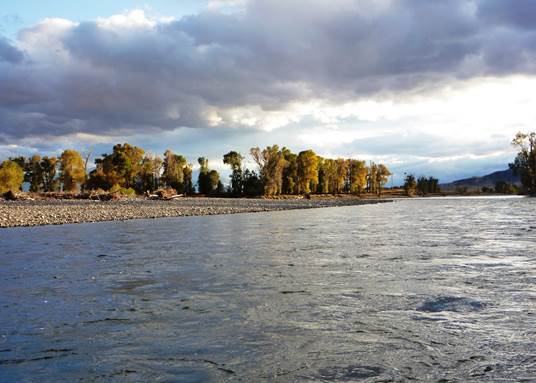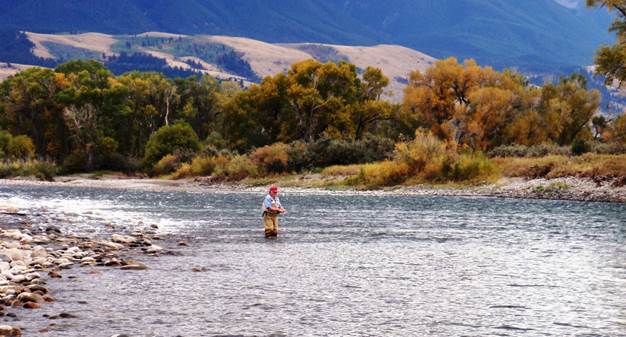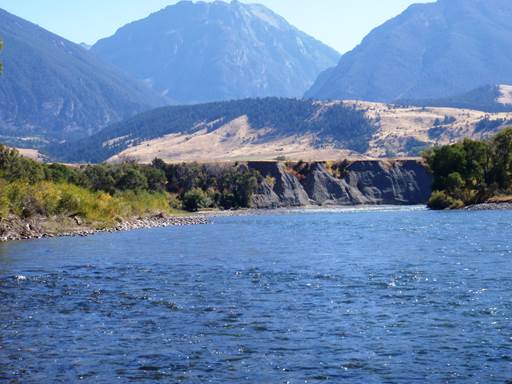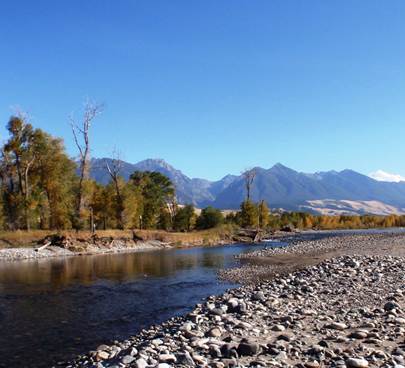THE ENIGMA THAT IS THE YELLOWSTONE RIVER (part 2)
"If you can learn to read the waters of the Yellowstone River and consistently take trout, you can travel the world and consistently be a successful fly angler."
Don Williams, 1976, Montana Fly Fishing Legend
| Sysadmin Note |
|---|
| Part 1 can be found here |
In this article I will be dealing with the Yellowstone River from the boundary of Yellowstone National Park to Billings Montana with a few notes and observations that extend to the river as it flows towards its confluence with the Missouri River near Williston, North Dakota.
Of all of the Montana Rivers that I fish the Yellowstone is by far the most challenging complex body of moving water within the state. Oh I am sure that the prior statement raised the hackles of a few of the readers who will soon be posting notes about how their river is tougher and more challenging, however before you grab the key board and start pounding out your incensed note I urge you carefully read the remainder of this article.

Where would you fish on this section?
On any given day on the Yellowstone River you can find yourself fishing anything from a size 2/0 streamer to a size 24 midge and anything in between. Furthermore, the Yellowstone River is a natural river meaning that it is undammed and therefore the flows are in a constant state of change. This means that throughout the season the trout are constantly adjusting their location, and places where you might take a reasonable trout in early July might to totally dry by early September and then you throw in the seasonal mix of insects which may not be consistent from section to section of the river and this all adds up to monumental challenge for the fly fisher.
Rivers like the Big Horn and the Missouri River below Holter Dam are exceptional fisheries by the hatches are fairly predictable and the flows are controlled by the Dams. Even the famed Spring Creeks of Paradise Valley are vastly less complex than the waters of the Yellowstone River. All of the complex challenges found on these rivers and spring creeks can also be found on the Yellowstone River but the micro-habitats, the wide range of food forms, the ever changing flows, the fact that it is a rather large and intimidating river combine to make the Yellowstone River one of the most complex and challenging waters in the west.
With all of these challenges what can the visiting angler do to overcome the difficulties offered by the Yellowstone River and be victorious? Some anglers believe that you must have a boat to successfully fish the Yellowstone River however this is simply not true. The Yellowstone River is one of accessible rivers in the State of Montana and from the Yellowstone Park boundary to Billings Montana there are some 41 different access sites. Not all of the 41 have boat ramps however the vast majority do have ramps.
The Montana Stream Access Law decrees that the public may use the rivers and streams for recreational purposes up to the ordinary high water marks, therefore if you gain access at a legal access site then you can fish up or downstream as long as you stay below the normal high water mark, which along the Yellowstone River is very visible. Just remember you cannot cross private land to gain access to the river without gaining the landowners permission. Now that I have done due diligence on the access issue I will move to the actual fishing.
Before fishing the Yellowstone River check with several of the local fly shops and find out what the flows are and what food forms are popular with the anglers at the time of your visit. The reason that I recommend checking with several shops is that you then receive more information and be able to pick and choose the methods and patterns that suit your fishing style or abilities.
The more information you have going into any fishing situation the better prepared you will be to make informed decisions on the various situations you can encounter. Remember knowledge is a bonus, not a burden.
This article is really pointed at the anglers who come to the Yellowstone River fish without a guide; if you are fishing with a guide your guide should be able to point out the proper places to fish. I suggest that you ask for a teaching guide, someone who will teach you where to fish the river and explain why you are fishing those places.
Now for those anglers who choose to challenge the Yellowstone River without the use of good fly fishing guide the first thing you need to do is collect information as to the flows and food forms available at the time you wish to fish the river.
To check the flows go to: https://waterdata.usgs.gov/mt/nwis/current?type=flow this will allow you to check the flows and the history of the flows before you actually venture forth to the river. Then check with several of the local fly shops to see what they are recommending as it pertains to fly patterns and suggested locations for the wading angler.
I would also suggest that you obtain a copy of Fly fishing the Yellowstone River, An Angler's Guide, by Rod Walinchus and Tom Travis. It was published in 1995 and unfortunately is out of print but can be obtain through used book dealer and there are copies for sale on Amazon.Com. This book deals only with fly fishing the Yellowstone River and breaks the sections of the river down offering hatch charts, maps and tips for each section and I know that some of the information is true as I am the Co-Author.
Now for the river, many anglers are overwhelmed by the sheer size of the Yellowstone River however size really doesn't matter. It is all about understanding where the trout will be and where to look for them.
Before we break the information on the river into the various seasons I would like to remind you to check the overall weather pattern for the year and the snowpack for the year. In the winter of 2010/2011 we received a heavy snowpack followed by a cool wet spring with lots of rain and snow. As a result the annual run-off which normally begins in late April didn't begin till mid-June 2011. Therefore the Yellowstone River was not fishable until early August and it set all kinds of records for high flows. In the winter of 2011/2012 the snowpack was light and the run-off was on time and the river was fishing by late June. Therefore knowing the overall weather conditions and if the area is in a drought is important for the angler wishing to challenge the Yellowstone River. As you can see a little bit of time spent gathering information pays big dividends.
From December to through February is considered the winter season and during this time of the year the river is at its lowest flows and the fishing is limited by the wind and the air temperatures. The best places to fish during this time of year are the riffles which are very well defined and easy to locate. The best method for this time of year is nymphing however the angler needs to be aware of the water temperature.
The water temperature will give the angler an idea of how active the trout will be at that time. Another tip for the winter angler is to find a section where there is a spring creek or a hot spring entering the river. In the general area of this warmer water the trout will be much more active. During late February I have encountered Midge Hatches and then I would looking for the riffles and flats below them and looking for the big easy back eddies since all of these places will produce trout. During the winter months the best time of day to fish is during the warmest part of the day. Remember this time of year the days are still pretty short and the weather can be raw therefore be cautious when wading as this is not the time of year to swim in the Yellowstone River. I have also used sculpin imitations during the winter but I am dead drifting them with very minimal twitches.
The spring runs from March to the end of May, however, be warned, March and April will still be dotted with many snowstorms and at times the angler will be wondering if winter is over. However, from mid to late March until early May can be one of the finest times to be fishing the Yellowstone River and, yet except for local anglers, the river sees very few anglers during this time period.
During March and throughout April the flows will increase but normally will still be on the low side and the river is very easy to wade during this time period.
Now, during this time period there is a lot going on, the angler can encounter midge hatches, Baetis hatches, the March Brown hatch and the famous Mother's Day caddis hatch. Furthermore, the rainbow trout spawning run will be taking place and as the water temperature warm and the brown trout will become very active. The majority of the rainbow trout move to the tributary streams to spawn. Streams like the spring creeks of Paradise Valley are open for fishing, but check the regulations as some of the tributary streams are not open to fishing at this time.

Fishing along the edge currents below a riffle
Here again the wading angler needs to look for the riffles, side channels, and edge currents remembering to look for places where the currents feed the trout. Trout are always holding in places where the current will feed them without them expending too much energy and where the water is either deep enough to protect them from predators or riffles where the broken water also offers them protection.

Look upstream to help read the currents
When dealing with the Yellowstone River do not look at the river as a whole but break it down by starting at the edges and when looking at the river trying to decide the current flows, always look upstream. It is always easier to read the currents when looking upstream. Remember many of the anglers in boats will be casting in towards the shore.
During the month of May, during a normal weather cycle, the river will begin to discolor and rise and the fly fishing will be over until late June when the river begins to drop and clear. Now I have seen exceptions to this but the ability to fish the Yellowstone River past the 5th of May is nothing that you can depend on, but if you are here and the river is fishable that's great. The Cutthroat Trout also begin their spawning run during late May and into June; however they are primarily tributary spawners.
The months of summer are June, July and August and of course this is one of the most popular times to fish the Yellowstone River. Much of June will find the river unfishable in a normal year, however toward the end of the month the river will begin to clear and drop. This is especially true during a low snowpack year.
The end of June or early July brings one of the most anticipated hatches of the year and that is the salmon fly. Now this time period can be an interesting time for the wading angler as the water levels are up and the current speed is at one of the highest points of the year. However, the wading angler can effectively fish the salmon fly hatch as the stoneflies (Pteronarcys californica) prepare to emerge they migrate to the shore and crawl out on rocks, bushes, grass or logs to spilt their nymphal shuck and emerge as adults. Because of the migrating stoneflies and the fact that current speed and flows are up the trout move into the shoreline of the river to feed on the migrating nymphs and the adults that fall out of the bushes.
The best place to start chasing the salmon flies is to begin at the town of Emigrant and follow the hatch upstream toward the boundary of Yellowstone National Park. Unfortunately you can't depend on being able to fish the river every year during the salmon fly hatch, and the best you can hope for is 50%. If you are checking the snowpack and the run-off conditions and can plan carefully you can hit the hatch, but just showing up is not a good idea. During and just after the Salmon Fly hatch you will also encounter yellow sally stones, golden stones along with several species of caddis and mayflies. Including both the western green drake and the gray drake hatch however these hatch are not river wide but can be found in pockets along the length of the river.
Here the wading angler has the advantage and when you find the hatch move slowly and stay in the area of the hatch, where most of the floating anglers keep going and fail to stay in the area of the hatch.
July and August brings a whole host of hatches and throughout the summer the water levels will drop and as that happens the trout will move off the banks to water and current edges that will feed them and offer them protection. This movement of the trout is ongoing throughout the season as the water levels decrease and the trout will adjust their positions to meet their needs of survival. As the water levels fall the riffles, runs, flats and tailouts become much easier to identify and for the anglers to recognize.
August also brings on the season of the grasshoppers it is another time period for which the Yellowstone is well known and both wet and dry hoppers are effective. Here again the wading angler should check the fishing reports at the shops to find the best sections of the river to fish with hoppers.
Throughout the summer there are several hatches which the angler may encounter and these hatches are seldom river wide, therefore the angler must be observant and prepared to take advantage of those hatches which are encountered.
If you are planning a summer trip to the Yellowstone River, don't forget your sunscreen and don't forget to drink plenty of water. The base elevation in Livingston is 4250 feet and it is easy for those not use to the higher elevation to dehydrate and sunburn which is a real threat during the months of summer and can ruin your fun if you are not careful.
I am often asked if the river is crowded, and my answer is no, Montana has barely over a million people in the state and Montana is the fourth largest state in the nation. I often send folks to an access site and I am questioned whether these areas are fished out, again my answer is no, the floaters are putting or taking out at access sites but not doing any serious fishing in those areas and some of my favorite wading sites are right at access sites.

Don't neglect the side channels
Soon the days begin to grow shorter and the days of fall are upon us with the months of September, October and November. This one of my personal favorite times of the year and there great fishing opportunities as the hatches of fall begin and through September the hoppers will fade. September also brings on the flying ant swarms and toward the end of the month the brown trout will leave their normal positions to gather in the pools in preparation for their annual spawning run.
Unlike the rainbow trout and cutthroat trout which are primarily tributary spawners the brown trout will spawn in the main river. During late September and into October the Rocky Mountain whitefish are also spawning
Now I know that many anglers dislike catching the whitefish, however they live in the same water and eat the same things as trout and the fly angler is going to catch them. Therefore enjoy them since they sure beat catching nothing. I know anglers who claim that by fishing dry flies you can avoid the whitefish and that is true to a point, however if there is a decent fall drake hatch or good midge or Baetis hatch you will not be able to avoid the whitefish. I have heard how anglers can pick the trout out during the hatch and only catch the trout, well good luck with that routine on the Yellowstone. Therefore as I stated earlier enjoy them as they are one of the only two native species found in the Yellowstone River at the time the famous Lewis & Clark Expedition.
As the water temperatures cool and the spawning brown trout become more active you also have the bonus of the rainbow's as they will follow the browns and feed on the eggs that drift out of the redds. Some of the largest rainbow trout of the year are taken during the brown trout spawning run.
As September wanes the day become shorter, the water levels continue to decrease and the water temperatures also decrease and finally anglers seem to vanish from the river, yet the trout remain and the visiting angler can still enjoy some truly remarkable fishing.
Generally speaking the talk of spawning brown trout brings visions of large streamer imitations to mind and though these patterns are effective there are still many dries to fish and nymphs of various sizes to employ. Unfortunately certain seasons of the year are stereo-typed as to the type of flies that are used; however the savvy angler will have several different pattern styles in their vest.
The biggest problem that anglers have on the Yellowstone River is that they compare it to other rivers and in our point and click world of instant gratification the do not have the patience's to properly fish the river. When I am planning a walk/wading day on the Yellowstone River I choose several different access points and I move upstream or downstream if the fishing in the first location proves to be slow.
Whenever I travel I always check the on-line fishing reports and upon arrival I also check with the local fly shops to gauge the tempo of the river as to when the hatches are occurring or what time of day the best fishing is to be found, and what type of water has been producing the best fishing, and that information will allow me to better plan my day.
Finding the riffle, runs, flats and back eddies is not all that hard, just remember that the trout need currents which will feed them and protection against predators. That does not mean looking for the main current as sometimes the main current is too fast and the off speed current may better suit the trout and therefore the angler.
The greatest challenge that any angler faces when fishing unfamiliar water is what I call the confidence factor! But if you have done your homework and come prepared to fish your chosen water and if you are comfortable with your fishing abilities then fish with confidence. Trout are trout and trout water is trout water and the trout in the Yellowstone are no different than trout found in many other rivers.
Regardless I figure the Yellowstone will continue to baffle anglers as they will continue to be awed by its size and length and that is truly a shame for the Yellowstone is truly one of the great rivers in the trout fishing world.
Enjoy & Good Fishin'
| Sysadmin Note |
|---|
| Part 3 can be found here |
